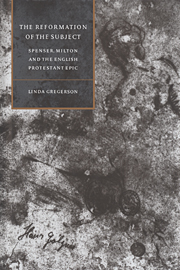Book contents
- Frontmatter
- Contents
- Acknowledgments
- Introduction
- 1 Emerging likeness: Spenser's mirror sequence of love
- 2 The closed image
- 3 Narcissus interrupted: specularity and the subject of the Tudor state
- 4 The mirror of romance
- 5 Fault lines: Milton's mirror of desire
- 6 Words made visible: the embodied rhetoric of Satan, Sin, and Death
- 7 Divine similitude: language in exile
- List of works cited
- Index
3 - Narcissus interrupted: specularity and the subject of the Tudor state
Published online by Cambridge University Press: 08 October 2009
- Frontmatter
- Contents
- Acknowledgments
- Introduction
- 1 Emerging likeness: Spenser's mirror sequence of love
- 2 The closed image
- 3 Narcissus interrupted: specularity and the subject of the Tudor state
- 4 The mirror of romance
- 5 Fault lines: Milton's mirror of desire
- 6 Words made visible: the embodied rhetoric of Satan, Sin, and Death
- 7 Divine similitude: language in exile
- List of works cited
- Index
Summary
Edmund Spenser and his contemporaries took for granted what we are only now rediscovering: that the subject is a constructed thing, a “creature.” One was a creature of God; one might be the creature of a prince or some other mighty patron. The premises of Tudor subject formation are in many respects quite foreign – and quite frankly antipathetic – to us now. Hence the considerable usefulness of the Tudor subject. Signaling as it does from across a great political and religious (and Romantic) divide, this subject is well positioned to estrange and thus to render visible the assumptions upon which our own understanding – our own experience – of subjectivity is grounded.
Creatureliness in early modern England was a concept possessing both theological and political valence and was firmly embedded in a hierarchical, indeed a patriarchal, understanding of creation. The sixteenth-century subject was conceived not as the locus of interiority but as a thing of radical and functional contingency. The word subject (from the Latin sub, or “under,” and jacere, “to throw”) was indissolubly predicated in this period upon subjection, as the OED implacably testifies, and as Raymond Williams and Peter Stallybrass, among others, have lately reminded us. Williams and Stallybrass both insist upon the subject's grounding in patterns of dominance-and-subordination. Both are interested in the complex processes of inversion by which the subject and subjectivity acquired their more recent prestige.
- Type
- Chapter
- Information
- The Reformation of the SubjectSpenser, Milton, and the English Protestant Epic, pp. 80 - 110Publisher: Cambridge University PressPrint publication year: 1995



